Leonardo Da Vinci was gay? That is a question that is constantly repeated. There is much interest in knowing everything that has to do with the genius of Leonardo Da Vinci. As we will see, he was accused of it and, even, Sigmund Freud studied on the subject.
Brief biography of Leonardo Da Vinci
Leonardo da Vinci. Vinci, Italy 1452 – Amboise, France 1519
Da Vinci’s talent was forged around the artistic movement known as the Renaissance, perhaps contributing directly to the history of Art and knowledge advancing faster and with more certainty.
The Renaissance meant leaving behind the obscurantism of the Middle Ages, the return to the classical model of Greece and Rome to reach the modern consciousness of a more splendid new time.
Da Vinci was the son of a peasant and a wealthy notary, who fulfilled a family tradition dating back three generations.
Freud’s studies on Leonardo
Some personal details are known from his personal life, others have tried to discover. The father of psychoanalysis, Sigmud Freud, wrote at the beginning of the last century a monograph “on the relationship of Leonardo’s libido and his alleged homosexuality.”
Freud, based on the biography of the artist and the relationship he had with his mother (very close to her in the first years of his life and separated from her later) and comparing it with other cases, concluded that Da Vinci lived the repression of the to be able to continue the (extreme) love he professed towards his mother, projecting it towards himself and “takes as a model his own person, in whose likeness he chooses his new erotic objects”. Therefore, Freud believed that Da Vinci was homosexual, serving his case to extrapolate it to others.
Leonardo Da Vinci accused of sodomy

The truth is that after passing through the School of Andrea De Cione, a multifaceted artist whose study developed artistic commissions of all kinds (painting, sculpture, manufacture of musical instruments), Leonardo was accused of sodomy with three colleagues and a Young man known in Florence for practicing prostitution.
After two judicial hearings they were acquitted for lack of evidence, although, at that time, it was considered that the accusation that weighed on Leonardo and his companions could be false, propitiated by some malicious enemy, of those that History knew makes forget the names.
Da Vinci highlighted his talent at the Cione School, also known as Verrocchio (true eye).
Leonardo not only surprised his artistic prowess with painting, but also stood out for his “beautiful appearance, his strong body, his physical grace and his ability to sing with the lyre,” as chronicles written by those who knew him reflect. In Florence, where he developed his first studies, he liked to attract attention.

Apparently Da Vinci used to walk in brightly colored suits or dressed in robes, attire of the time, shorter than normal.
They also tell him that, from time to time, it was his custom to buy caged birds and then release them by returning them freedom.
Da Vinci always showed ambiguous aspects in his personality.
As if he lived with intensity the narrow difference that separates fear and desire.
Perhaps for that reason, his first drawings represented deformed faces of real people that he found in his walks in Florence, but that called his attention for the very repulsion that they generated.
Similarly, when he began his anatomical studies at the Maria Nuova Hospital, he found a contradiction between the horror of death (and the poor conservation of bodies due to lack of conditions) and the need for research, which was what I really pushed him.
The first complete dissection of a human body
Da Vinci is considered as the first man who dissected a body through the superficial layers. His anatomical studies are still considered a prodigy of precision and accuracy.
Da Vinci did not stop in the study of painting or anatomy.
He studied geometry, the mechanics of the flight of birds, outlining models of flying machines, because his purpose was to get man to fly.
He also studied botany, even devised military devices (which were never built), but that on paper was machinery capable of making armies unbeatable.
Many have seen in these schemes the outline of modern tanks or the use of poison gas.
Da Vinci, little saver
The chronicles tell that Da Vinci, always under the protection of great patrons, lived to the limit of his income.
He began many commissions to maintain his train of life, while studying architecture, astronomy or stopping in the study of the division of rivers or drainage of swamps.
In the more than 4000 manuscripts that are preserved from its production, mysterious notes have also been found, since they can only be read by placing them in front of a mirror.
Da Vinci is not considered to have an interest in hiding his investigations, although no explanation has been determined.
As a multidisciplinary genius, Da Vinci will always be remembered for his enigmatic painting “La Gioconda”.

His favorite work (he always took it with him on his travels) and the most famous portrait in history. In it he used the “sfumato” and chiaroscuro, two techniques of which he was a precursor.
Another creation by Leonardo Da Vinci, the Sfumato, what Instagram does with your photos
Mona Lisa’s mysterious smile is a sign of sfumato. Technique with which the contours of the lines are removed, which appear blurred in a kind of evocative fog that catches the viewer.
Da Vinci ended his days as a painter of the court of Louis XII of France, with 67 years he continued to devise wits, devices and works of art.
